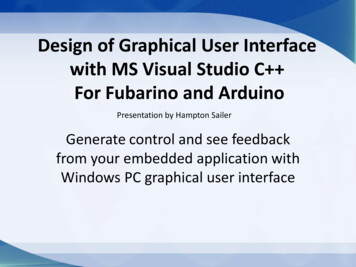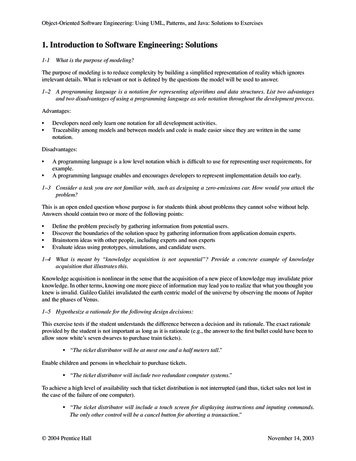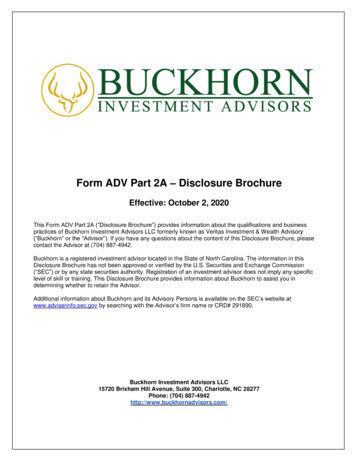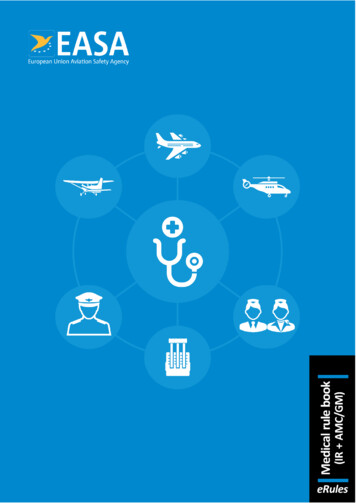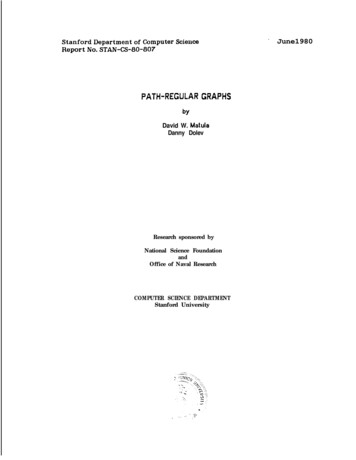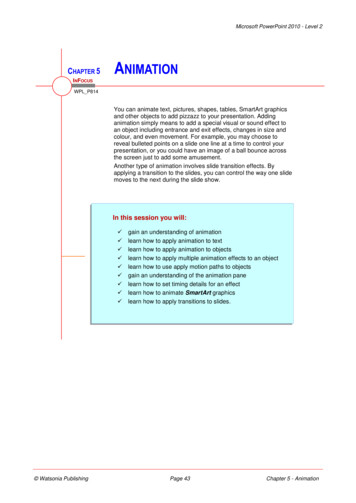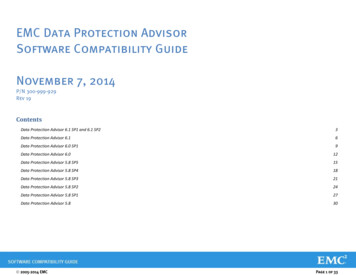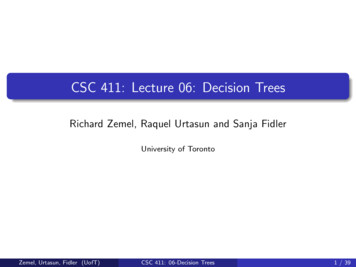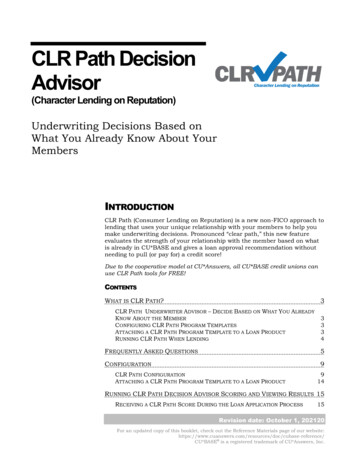
Transcription
CLR Path DecisionAdvisor(Character Lending on Reputation)Underwriting Decisions Based onWhat You Already Know About YourMembersINTRODUCTIONCLR Path (Consumer Lending on Reputation) is a new non-FICO approach tolending that uses your unique relationship with your members to help youmake underwriting decisions. Pronounced “clear path,” this new featureevaluates the strength of your relationship with the member based on whatis already in CU*BASE and gives a loan approval recommendation withoutneeding to pull (or pay for) a credit score!Due to the cooperative model at CU*Answers, all CU*BASE credit unions canuse CLR Path tools for FREE!CONTENTSWHAT IS CLR PATH?3CLR PATH UNDERWRITER ADVISOR – DECIDE BASED ON WHAT YOU ALREADYKNOW ABOUT THE MEMBERCONFIGURING CLR PATH PROGRAM TEMPLATESATTACHING A CLR PATH PROGRAM TEMPLATE TO A LOAN PRODUCTRUNNING CLR PATH WHEN LENDING3334FREQUENTLY ASKED QUESTIONS5CONFIGURATION9CLR PATH CONFIGURATIONATTACHING A CLR PATH PROGRAM TEMPLATE TO A LOAN PRODUCT914RUNNING CLR PATH DECISION ADVISOR SCORING AND VIEWING RESULTS 15RECEIVING A CLR PATH SCORE DURING THE LOAN APPLICATION PROCESS15Revision date: October 1, 202120For an updated copy of this booklet, check out the Reference Materials page of our base-reference/CU*BASE is a registered trademark of CU*Answers, Inc.
RUNNING A CLR PATH SCORE USING AN ACTION CODEVIEWING A CLR PATH SCORE USING AN ACTION CODE2CLR Path Decision Advisor1719
WHAT IS CLR PATH?The CLR Path feature allows you to “score” a member based on what youalready know about them, without pulling a credit report. Let’s learn moreabout this feature “in a nutshell.”CLR PATH UNDERWRITER ADVISOR – DECIDE BASED ON WHAT YOUALREADY KNOW ABOUT THE MEMBER Learn More: FAQs: Page 5.CLR Path (Consumer Lending on Reputation) is a non-FICO approach tolending that uses your unique relationship with your members to help youmake underwriting decisions. Pronounced “clear path,” this featureevaluates the strength of your relationship with the member based on whatis already in CU*BASE and gives a loan approval recommendation withoutneeding to pull (or pay for) a credit score!Due to the cooperative model at CU*Answers, all CU*BASE credit unions canuse CLR Path tools for FREE!Interested in learning more? Check out the CU*Answers Store page devotedto CLR Path: GURING CLR PATH PROGRAM TEMPLATES Learn More: Page 9.Configurable, customizable, and FREE, CLR Path evaluates data you alreadyown – most of which the credit bureaus don’t even know – such as how longthe membership has been open, member age, account balances, loanhistory, and ACH/payroll deposits. You give points for each criterium, andcan even give negative points for attributes such as delinquency. You canconfigure as many CLR Path program templates as you wish.This section also covers what tables (files) and columns (fields) CLR Path uses.ATTACHING A CLR PATH PROGRAM TEMPLATE TO A LOAN PRODUCT Learn More: Page 14.Once the CLR Path program template is configured, it is then attached to aloan product. During the loan application process, if the loan is attached tothis loan product, the CLR Path criteria are run against the member.CLR Path Decision Advisor3
RUNNING CLR PATH WHEN LENDING Learn More: Page 15.The CLR Path Decision Advisor runs at the time of the loan application andgives a score for the primary member. (Joint Owners and non-members willnot be evaluated.) You can also run the member against a selected programtemplate and view prior scores attached to the membership via Action codes.4CLR Path Decision Advisor
FREQUENTLY ASKED QUESTIONSWhen is CLR Path run?If a CLR Path configuration is associated with the loan product attached tothe loan, the CLR Path Decision Advisor score is run during the loanapplication process before the loan officer moves to the Loan Summaryscreen.Additionally, you can run a CLR Path score by selecting Tool #53 ProcessMember Applications, entering a member number, and then choosing theAction Code CLR Decision – Run.How much does it cost to use the CLR Path Decision Advisor?Use of the CLR Path tool is free, one of the many benefits of belonging to thecooperative network.What are the supported loan types?All loan types that are configurable by your credit union can use CLR Path.There are no database restrictions.Does CLR Path support automatic approvals?No. At this time, automatic approvals are not supported. After running CLRPath, your credit union can use your policies and procedures to evaluate theresults to help you make your final approval determination.Are CLR Path result records purged? Where are theyretained? Does the system retain the result when a loan ispaid off?If the CLR Path result record is not attached to a booked loan, the CLR Pathresult record is purged after 93 days.When the loan officer books the loan, the loan suffix is added to the CLRPath result table (CLRPRESULT). This score and associated report # are notpurged and are retained even when the loan is paid off.What counts as a passing CLR Path score?Your credit union will enter a minimum score to pass in the CLR Pathprogram configuration.The member receives a passing score if their calculated score is equal to orgreater than your minimum score. A passing score appears in green on theLoan Application Summary screen. (A red score indicates a failing score.)Are joint owners or non-members evaluated with CLR Path?No. Only the primary borrower is evaluated for a CLR Path score. CLR Pathis not run on joint owners or non-members.CLR Path Decision Advisor5
Can we have different sets of criteria? Can we have multiplecriteria for a loan product?Yes and no. There is no limit to the number of program templates you canbuild to hold your decision parameters, but only one CLR Path programtemplate can be attached to a loan product at any time.Do specific criteria need to be met for CLR Path to be run on aloan?No. Unlike the Lender 247 Decision Model, CLR Path does not requiresspecific criteria to run the score calculation. When the loan officer works onthe loan application, the CLR Path program template associated with theloan product runs automatically.Can you assign negative points towards the calculation of aCLR Path score?Yes. If a criterium is activated in the CLR Path configuration (configured inTool #1110 Configure CLR Path Criteria), a value is required, andnegative points are allowed. For example, you can give negative points tomembers who have written off or charged off loans.Can a member receive zero points for a criterium in a CLRPath score?If the number 0 appears in the “Earned Points” column of the CLR Pathdecision detail, the scoring used the criterion, but the member did not meetthe requirements to receive points. For example, the member might not havea loan when points are given for having a loan balance.Why am I not seeing results for all configuration criteria in mymember’s CLR Path score?CLR Path results are calculated using criteria that are checked (active) in theconfiguration (configured in Tool #1110 Configure CLR Path Criteria).If you leave a criterium unchecked in the configuration, the member will notbe evaluated on that metric, and it will not appear in the decision results.Remember that the member was scored based on the configuration settingsat the time they were scored. If the configuration was subsequentlychanged, this will not be reflected in a score run prior to the change.Are soft pull credit scores considered when evaluating withCLR Path?Yes. CLR Path uses soft pull credit scores when evaluating a member on thecredit score criterium.6CLR Path Decision Advisor
Is the member evaluated for the delinquency of loans that arepaid off or closed?The CLR Path configuration allows you to evaluate a member on thecriterium of Loans (active and closed) have been delinquent more than XXtimes.When you elect to include this specific criterium in the program template (bychecking it in Tool #1110 Configure CLR Path Criteria), members runagainst the program are scored based on the delinquency of current as wellas closed loans.Can you exclude members with specific membershipdesignations from having CLR Path run on their loans?Yes. The configuration (accessed by selecting Tool #1110 Configure CLRPath Criteria) allows you to exclude membership designations. Anyprogram template that excludes a membership designation is not runagainst a loan of a member with that membership designation.Am I limited to one CLR Path score per day?A CLR Path score is calculated the first time a loan application runs eachday. Any subsequent running of the loan application that same day will notresult in another score being calculated.To run another score, use Tool #53 Process Member Applications andaction code CLR Decision – Run. Select the member and the programtemplate and the system will calculate another score.Another more obscure way to get a second score in the same day is tochange the CLR Path program template associated with the loan productitself. In this case, when the loan application is accessed, the system wouldcalculate a new score with the different template.What happens when the member has more than one CLR Pathscore?If you use Tool #53 Process Member Applications, select the member, andthen Action Code CLR Decision – View Results, and the member has multipleCLR Path scores, a window will display listing all the scores with the CLRPath Report #. From there, you can select to view the detail of each score. (Ifonly one score is available for the member, you will automatically move tothe detail screen.)Can I print the CLR Path score breakdown?Yes. There is a print button on the CLR Path score detail screen allowingyou to archive the member’s score and details to ProDOC. You can also usethis button to print this information to a printer.Can I delete a configured CLR Path program template code?You cannot delete a CLR Path program template code (configured in Tool#1110 Configure CLR Path Criteria) if it is attached to a pending loanapplication. To delete the code, first delete the application or book the loanattached to that program template.CLR Path Decision Advisor7
Is the CLR Path score on the Summary Loan Applicationscreen for the current day?Yes. The CLR Path score displayed on the Summary Loan Application screenis always for the current day.Will the CLR Path score appear on the Loan Creation screen?Yes, if appropriate. The CLR Path score conditionally displays the CLR Pathreport # field if a score was run for the loan application.8CLR Path Decision Advisor
CONFIGURATIONCLR Path program templates evaluate data already in the system such ashow long the membership has been open, the member’s age, accountbalances, loan history, and ACH/payroll deposits. In the configuration yougive points for each criterium, and can even give negative points forcriterium such as delinquency.CLR PATH CONFIGURATIONTo configure a CLR Path program template, use Tool #1110 Configure CLRPath Criteria.This will take you to the entry screen listing your configured programtemplates. You can also edit, copy, delete, and view existing templates fromthis screen.Configure CLR Path Criteria (Tool #1110)To create a new program template, use Add (F5)CLR Path Decision Advisor9
CLR Path Program Configuration Screen DetailThe top of the screen allows you to identify the program template, to excludeaccounts of certain membership designations, and to activate the programand supply a passing score.Field Descriptions10Field NameDescriptionCodeEnter a code to be used when connecting this programtemplate to a loan product or when running CLR Pathindependently of loan processing.DescriptionEnter a description identifying this program.Exclude ifmembershipdesignation (xselected)Use the Select button to select specific membershipdesignation. This program will not be run againstmemberships of these membership designation(s).Activate criteria andspecify points:Minimum score topassMinimum number allowed for this field is 1 (one).CLR Path Decision AdvisorUse this to activate this program template and to set theminimum passing score. (Members having this score orgreater will receive a passing score.)
In the next section of the screen are the criteria you can use to develop yourprogram template. Give points for the criterium you wish to use. You cangive negative points. To activate the criterium, you must check the boxto the left. Otherwise the criterium is not used in the evaluation when theprogram template is run. This allows you to have different criteria for eachprogram.Members do not need to meet any special criteria to have a programtemplate run against them as they do with 247 Lender.A member can receive zero points for a criterium in the CLR Path results. Ifyou do not check a criterium, it will not show in the CLR Path results detailscreen and will not be used to calculate the score. If you subsequently alterthe program template, the existing results will still show results based on thecriterium used when the score was originally calculated. NOTE: The final score is saved in the CLRPRESULT table (file).Field Descriptions (With Tables/Files and Columns/Fields Used)Membership open atleast x monthsEnter a number of months to go back to look for an opendate. The system checks the Master table (file) and theOpen Date column (field).Member age betweenx and xPrimary member’s age is between x and x months.Most recent creditscore between x andx (if pulled in the pastx months)Credit scores in credit score history table fall betweenspecified range. The system will look back the specifiednumber of months to find the score.Average aggregateshare balance overthe previous xmonths of at least x(includeSH/SD/CD/IR/TX) The system checks the Master table (file) and theBirthdate column (field) and runs an age Query. NOTE: Soft pull credit scores are evaluated. The system checks the most recent score in theCRBCSH table (file) in the previous number ofmonths provided.The number of months to go back and check for a balance ofat least x dollars.The system will look at the types of accounts specified forthis balance. The system uses the MBRBAL table (file) and theEOM Balance columns (fields) to calculate a total.Then this is divided by the # of months. TheComparison data will show the total.NOTE: Since the MBRBAL file is an EOM file, thescoring only uses full calendar months and does notinclude the current months.At least x paid offloans in the previousx monthsThe specified number of loans have been paid off in thespecified number of months.Previous paid off loanbalance higher that xThe dollar amount to check against the distribution limit ofloans. The system uses the ACHIST5 and ACHIST6 tables(files) and looks for the WRTOFF column (field) witha value of 0 (zero). The payoff count also uses theCLODAT column (field) against today’s date.The system sums the DBLIMT column (field) in theACHIST5 and ACHIST6 tables (files) and alsoensures that the value of the WRTOFF column (field)is 0 (zero). Then it takes a sum of the disbursementCLR Path Decision Advisor11
amount and compares to the criteria that is enteredin the configuration.ACH and/or payrolldeposits of at least xper month overprevious x monthsThe dollar amount to check for ACH or payroll deposits.The number of months to go back to check for thesedeposits. The total ACH deposits for each month individuallyhas to be at least the dollar amount in theconfiguration.The system checks the HTRANS1 file for TransactionTypes 16 and 18 and looks at the date range chosein the configuration.Important note: Unlike all of the other date ranges,this configuration uses calendar months. Thismeans that the date range begins at the current dateand does not start at the prior month.Tiered services levelBasicPrimary member is Tiered Service Level Basic.Tiered services level APrimary member is Tiered Service Level A. Tiered services level BThe system looks at the score in the TIERDL table(file).Primary member is Tiered Service Level C. SEG/Sponsor code (xselected)The system looks at the score in the TIERDL table(file).Primary member is Tiered Service Level B. Tiered services level CThe system looks at the score in the TIERDL table(file).The system looks at the score in the TIERDL table(file).Use the Select button to move to a screen where you canselect the SEG/Sponsor codes. When you return to thisscreen, the number selected will appear.The system looks for the presence of this code in themembership. Insider/Employeetypes (x selected)The system looks for the selected Seg code(s) in theMASTER table (file).Use the Select button to move to a screen where you canselect the Insider/Employee types. When you return to thisscreen, the number selected will appear.The system looks for the presence of this type in themembership. Loan balance of x to xThe system reviews the range of dollar amounts to look forclosed-end loan accounts. LOC balances of x toxCLR Path Decision AdvisorThe system reviews the MEMBER5 table (file) andtallies a total of combined balances on loans byaccount base that have a status of Active.The system reviews the range of dollar amounts to look for ofopen-end loan accounts. 12The system looks for the selected Insider/Employeetypes in the MASTER table (file).The system reviews the MEMBER6 table (file) andtallies a total of combined balances on loans byaccount base that have a status of Active.
Loan category code (xselected)Use the Select button to move to a screen where you canselect the Loan categories. When you return to this screen,the number selected will appear.Look for the presence of this code in the loan of themembership. Loans currently indelinquent statusThe system will check if any of the member’s existing loansare delinquent. Loans currently overlimitLoan write-offs/charge-offs inprevious x monthsThe system reviews both the MEMBER5 andMEMBER6 tables (files) and looks for loans wherethe DLQBAL column (field) is not 0 (zero).The system will check if any of the member’s existing loansare overlimit. Loans active or closedhave been delinquentmore than x timesThe system reviews both the MEMBER5 andMEMBER6 tables (files) and looks for loans with theselected loan categor(ies).The system reviews the MEMBER5 and MEMBER6tables (files) and looks for loans where the CURBALcolumn (field) value is (greater than) the DBLIMTcolumn (field).The system will check if any of the members loans (open orclosed) are delinquent more than the selected number oftimes. NOTE: You can use this criterium to give negativepoints for both open and closed loans. The system reviews the MASTER table (file) and theDELQCT column (field). NOTE: There is no “previous xx months” timeframeassociated with this criterium. The value in theDELQCT column (field) equals the total number oftimes a loan is/was delinquent for every loan for themember in the MEMBER5, MEMBER6, ACHIST5,and ACHIST6 tables (files).The system will check if the member has any written off orcharged off loans in the previous selected number of months. The system reviews the LNWRTOFF table (files) andthe WOACCTBS and WOWDATE columns (fields).When all criteria changes are made, use Update (F5) to return to the entryscreen which will show the program templates created.CLR Path Decision Advisor13
ATTACHING A CLR PATH PROGRAM TEMPLATE TO A LOAN PRODUCTOnce the CLR Path program template is configured, it is then attached to aloan product. During the loan application process, if the loan is attached tothis loan product, the CLR Path scoring criteria is run against the member.To attach a CLR Path program template to a loan product use Tool #470Loan Product Config. Then select General Info. The field for entering theprogram template code appears in the center of the loan product screen.Only one code can be attached to a loan product at a time.Loan Product Config (Tool #470), “General Info”14CLR Path Decision Advisor
RUNNING CLR PATH DECISIONADVISOR SCORING AND VIEWINGRESULTSThe CLR Path Decision Advisor runs at the time of the loan application andgives a score for the primary member. (Joint Owners and non-members willnot be evaluated). You can also run the member against a selected programtemplate and view prior scores attached to the membership via Action codes.RECEIVING A CLR PATH SCORE DURING THE LOAN APPLICATIONPROCESSOne way you can run a CLR Path score for a member is to run it whilecreating a loan application. The CLR Path program template used is the codethat’s attached to the loan product used in the loan request.The CLR Path score is shown on the Summary screen. This screen showsthe CLR Path score. The score is in green if the member’s score is equal toor greater that the minimum score to pass. The score is in red if the score isless than the minimum score to pass.Loan Application Summary ScreenThe CLR Path score shown is always for the current day. Each day themember is only scored against the program criteria the first time the loanapplication is accessed.In order to calculate another score, use the Action Code covered in the nextsection of this booklet. Another more obscure way to calculate a new scoreCLR Path Decision Advisor15
is to attach a different program template to the loan product associated withthe loan request.To view the detail of the score, use the CLR Path Decision button to accessthe CLR Path Results screen, which shows a breakdown of the score.CLR Path Results ScreenOn this screen you see the CLR Path report number, the minimum score topass, the member’s score and the criteria used to calculate that score. NOTE: The CLR Path score uses the criteria active in the programtemplate configuration at the time the member is scored. If acriterium is not listed, that means that the member was not scoredon that item. A zero score can be given. This means that themember was scored and received no points toward a passing score.From this screen, you can print the details of the score and can archivethese results using ProDOC. Follow your credit union warranty.16CLR Path Decision Advisor
If available, the CLR Path Report Number can be found on the Loan Creationscreen.CLR Path Loan Creation ScreenThis score can be viewed using the CLR Decision – View Results Action codecovered in the following section.RUNNING A CLR PATH SCORE USING AN ACTION CODEYou can also separately run a member against a CLR Path program templateusing an Action code. In this manner it is possible for you to run a memberagainst different template and criteria to receive a different score.To calculate a CLR Path score on a member use the Loan Action code CLRDecision – Run.Following are some reasons you may decide to use this option. Since only one CLR Path score can be run on a member each day perloan application, you may use the Action code access point to run themember against a different program template to receive additionalscores in the same day.You may wish to run the member against CLR Path outside of theloan application process, such as to assist in making a decisionabout a new checking account or other service.CLR Path Decision Advisor17
To access the Action Code screen where you can select to run additional CLRPath program templates against the member use Tool #53 Process MemberApplications, enter an account number and use Enter. Because an actioncode is not entered, the Member Loan File Action Code screen will appearallowing you to select the appropriate code.Member Loan File Action Code ScreenTo run a CLR Path program template against the member to receive a score,select the CLR Decision – Run action code.You will be presented a screen allowing you to select the CLR Path programtemplate you wish to use.Select a CLR Path Program TemplateUse the lookup and use Enter and the CLR Path Results screen shown onpage 16 will appear for that program.18CLR Path Decision Advisor
VIEWING A CLR PATH SCORE USING AN ACTION CODETo view CLR Path scores previously run for the member, use the Action CodeCLR Decision – View Results. (Access to this screen is covered in theprevious section.)Member Loan File Action Code ScreenIf the member has multiple CLR Path results, the following screen willappear. This lists the CLR Path Report Number. From here, select a scoreto move to the CLR Path Results screen shown on page 16.If only one score exists for the member, you will move directly to the CLRPath Results screen shown on page 16.Multiple CLR Path Result ReportsCLR Path Decision Advisor19
Path score? If the number 0 appears in the "Earned Points" column of the CLR Path decision detail, the scoring used the criterion, but the member did not meet . To delete the code, first delete the application or book the loan attached to that program template. 8 CLR Path Decision Advisor Is the CLR Path score on the Summary Loan .
